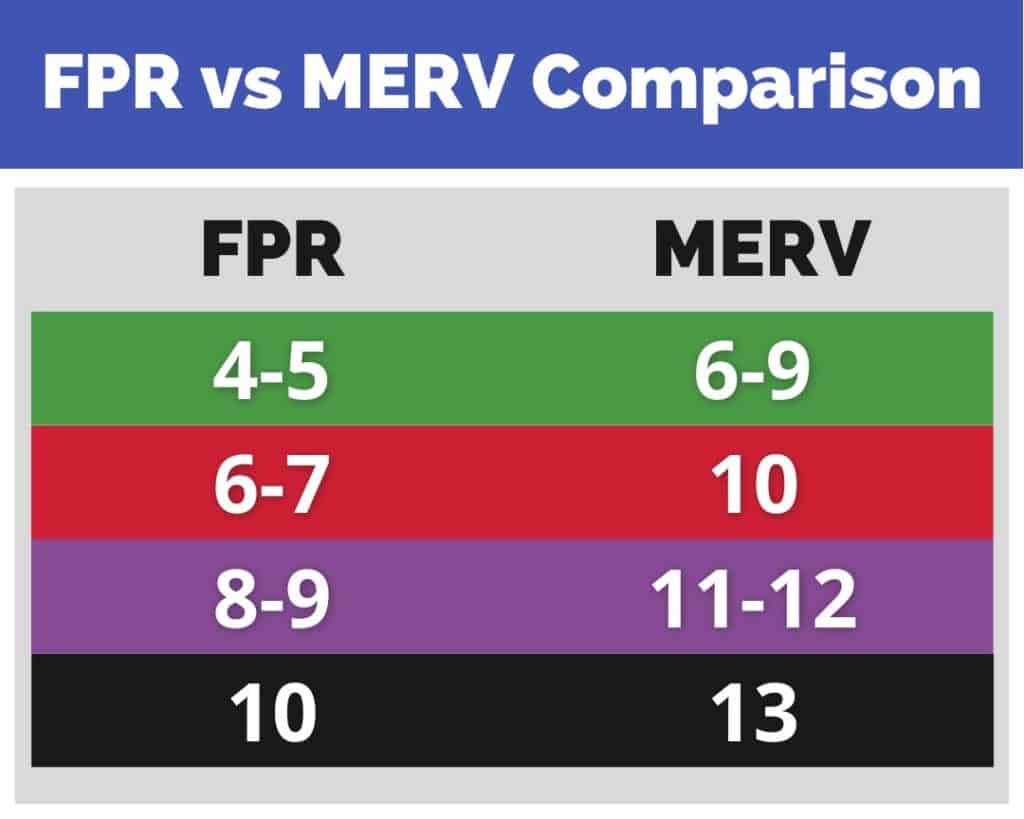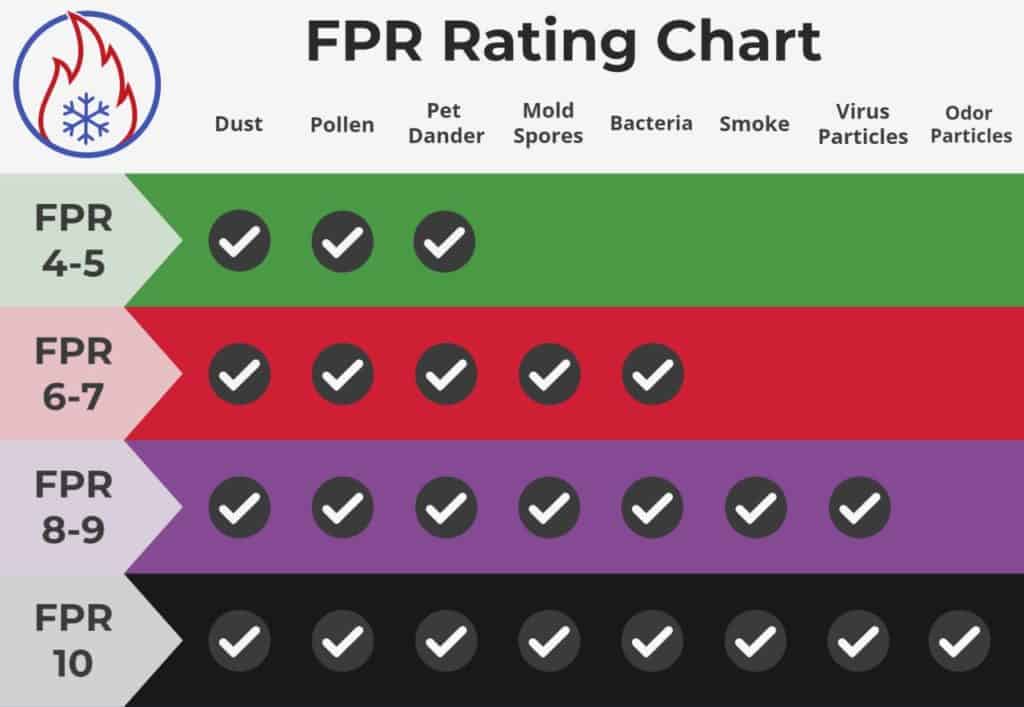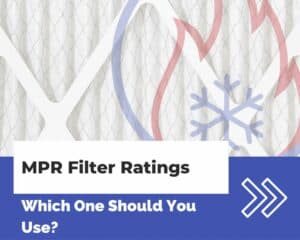If you’re shopping for an air filter from The Home Depot, you’ll come across the FPR system.
But what is the FPR system anyway? And how does it compare to the MERV system?
The difference between the FPR and MERV ratings is that FPR uses a scale of 1-10, while MERV uses a scale of 1-16.
The MERV system rates air filters strictly on their ability to capture particles. The FPR system goes a step further and also rates filters based on the amount of pressure drop they introduce and their dust holding capacity.
Both FPR and MERV rating systems measure an air filter’s ability to trap particles. However, the FPR and MERV rating systems have differences that make them difficult to directly compare against each other.
In this article, I’ll go over the differences between the FPR and MERV systems. I’ll also cover how the FPR system rates an air filter, and discuss the best FPR rating to use in your home.
FPR versus MERV rating comparison
The Home Depot provides a table that roughly compares FPR to MERV ratings. Besides the differences in numeric ratings, the FPR and MERV systems are weighed toward different criteria:
- The MERV system rates an air filter on its ability to capture particles. In order to obtain a certain rating, an air filter must capture enough particles to meet the minimum standards for E1, E2, and E3 particles.
- The FPR system goes a step further. In addition to rating an air filter on its ability to capture particles, the FPR system also includes pressure drop and dust holding capacity in its criteria.

What does FPR mean?
FPR stands for Filter Performance Rating. The FPR system was created by The Home Depot to rank filters by measuring their ability to capture large and small particles.
The FPR system uses a scale of 1-10, with 1 being the lowest performance, and 10 being the highest.
Here are the criteria that the FPR system uses to rate an air filter:
- MERV rating
- E1 particle capture efficiency
- Pressure drop
- Dust holding capacity
Unfortunately, The Home Depot does not provide the exact numbers that they use to assign FPR ratings to air filters. This means that we don’t know exactly what threshold must be met by an air filter to obtain a certain FPR rating.
The one thing that The Home Depot has published on its website is a table that gives a rough conversion of MERV, FPR, and MPR ratings.
Does this mean that you should stay away from air filters with an FPR rating?
Absolutely not.
In my opinion, the FPR system is a more comprehensive rating system for air filters compared to the MERV and MPR systems.
The FPR system takes into account the pressure drop and dust holding capacity of air filters—things that the MERV and MPR systems do not address.
The pressure drop of an air filter is critical to the overall performance of your HVAC system.
The pressure drop of an air filter directly affects how much airflow you’ll have through your system.
Higher pressure drop = less airflow.
That’s why I’m glad to see pressure drop included in the FPR criteria. It’s just unfortunate that we don’t know the exact numbers behind the ratings.
What FPR rating should you use?
For most residential homes, I recommend using an air filter with an FPR rating of 4-5.
Air filters with an FPR rating of 4 to 5 will provide a basic level of air filtration that is sufficient for most homes.
Additionally, filters with an FPR rating of 4 to 5 will not restrict as much airflow as filters with higher FPR ratings. This means your HVAC system will run more efficiently and you’ll spend less money on your utility bills.
If you have allergies, I recommend using an air filter with an FPR rating of 8-9.
Air filters with an FPR rating of 8 to 9 will filter out smoke, smog, and small allergen particles.
The main drawback of using filters with an FPR rating of 8 to 9 is that they will reduce airflow more than filters with a lower FPR rating. This lowers the efficiency of your HVAC system, causing higher utility bills.
Another drawback of using stronger air filters is that they get clogged up faster. You’ll need to change a stronger air filter more often than a weaker one.
One last thing—stronger air filters cost more. You’ll end up spending more money on air filters alone.
Air filter FPR ratings
The FPR system assigns a performance rating to an air filter based on its ability to capture particles, hold dust, and how much pressure drop it introduces into the system. The higher the FPR rating, the smaller the particles that a filter can trap.
- On the lower end, filters with FPR ratings of 4-5 can trap large particles such as dust, pollen, and pet dander.
- Filters with FPR ratings of 6-7 can trap smaller particles such as bacteria and mold spores.
- Filters with FPR ratings of 8-9 can trap smoke particles and particles that carry viruses.
- On the high end, filters with an FPR rating of 10 can trap tiny odor-carrying particles.
Here is a chart that shows the difference between FPR ratings in terms of what types of particles they can capture:





Can you clarify or explain more about pressure drop? You referred to how much pressure drop is introduced into the system. Does that mean the amount of pressure the moving air places on the filter as it travels through the return air vent? For example, if I try to blow air through a paper tissue, very little air would pass through it and the pressure drop would be relatively high on the other side of it (causing the blower system to work harder). On the other hand, if I blow air through a window screen, more air can pass through and the pressure drop on the other side of it would be less (and the blower won’t have to work as hard).
Thanks for your insight.
Hi John,
You’re correct. The paper would introduce a high pressure drop and the screen would introduce a lower pressure drop.
Pressure drop an indication of resistance to airflow in a system. To put it simply: more pressure drop = less airflow (all else being equal).
When your HVAC system is running, the pressure upstream (before the filter) will be higher than than the pressure downstream (after the filter). The difference in these two pressures is the pressure drop across the filter.